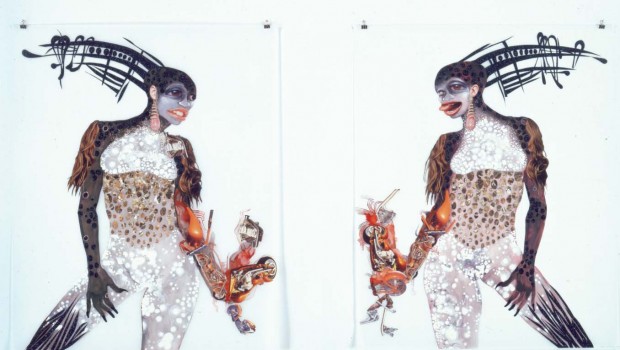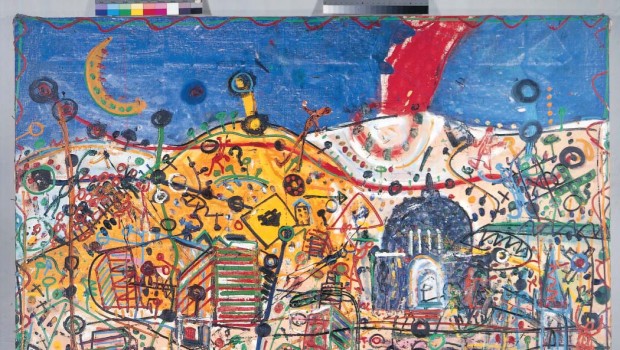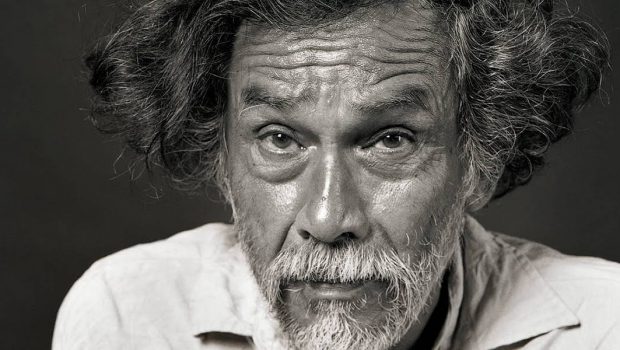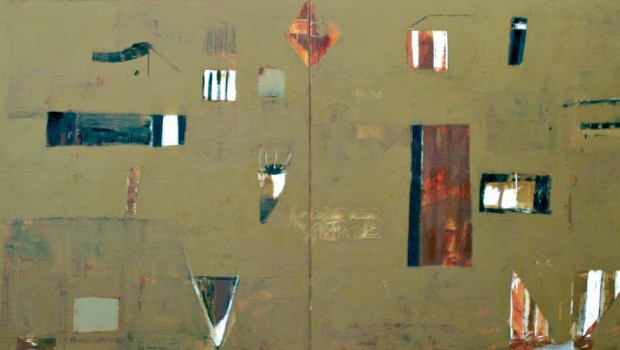Cyborg Consciousness in the art of Wangechi Mutu
Lissette Olivares
The Prosthetics of Feminity
Tropes of Futurity
Wangechi Mutu
Download Complete PDF / Descargar
In the early 21st century, our time, a critical time, we are all cyborgs–cybernetic organisms–cross breeds in a new industrial revolution, connected by global webs of information networks, and transformed by new technologies. Even Gaia, our Earth, has had her body modified through an ever growing technological colonization, where fiber optics, satellites and archival vaults can be found in even her most remote topographic regions. Scientific innovations including vaccines, the Internet, robotics, space travel, nanotechnology, cloning, genetic engineering, and postmodern war have changed how we perceive everyday life as much as how we imagine ourselves. This analysis examines how cyborgs have historically proliferated and how they have transformed in our imaginary, considering how cyborg consciousness can help us to examine the multiple layers of contemporary works of art, here specifically, the works of Wangechi Mutu.
Cyborgs acquired their name in a famous article published in 1960 by Dr. Manfred E. Clynes and Dr. Nathan S. Kline, who used the term to identify the “biological evolution” that would “free man to explore.”1 Central to their research was the desire to create and develop “man-machine” self regulating systems that would help humans reach, survive and thrive amongst the stars. The doctors believed that the development of technologically advanced prosthetics would revolutionize future scientific research and space travel. Despite their enthusiasm for the fusion between “man” and machine, their text exemplifies a scientific framework that glorifies technological advancement but which fails to consider extended political impacts. For example, language such as “exploration,” and repeated emphasis on “man (as in “man-made,” or “man-machine”) reveal underlying and unquestioned colonial and patriarchal tropes prevalent within scientific discourse at this historical conjuncture.
Twenty-five years after the interpellation of the cybernetic organism, theorist Donna Haraway unleashed her seminal “Cyborg Manifesto,” which rearticulated the cyborg as a blasphemous creature, both real and imagined, but ultimately capable of creating an oppositional politics in this advanced technological horizon.2 Drawing inspiration from a range of feminist work, Haraway iterates an ontology for the cyborg that is neither fixed, unitary, nor taxonomic but which thrives under a process of continuous becoming. Cyborg consciousness as developed under this radical feminist hermeneutic, relies on the consideration of how we as hybrid subjects in a new world order construe a movement capable of critically responding to these technologies that have spawned us.3
Haraway’s cyborg provides a considerable shift away from the dominant scientific rhetoric that frames the cybernetic organism under a discourse of advanced technological progress. Instead, Haraway’s elaborations become theoretical and political prostheses that get aggregated to the previously uncomplicated cyborg body and imaginary that mainstream science has propagated. Indeed, Haraway’s cyborg myth has triggered a plethora of additional theoretical appendages which continue to elaborate how the figure of the cyborg can enunciate the intersections of gender, race, and class in relation to current and historical developments in science and technology.4 Just as prosthetics are central to the creation of the cyborg, and to its evolution as an oppositional subject, so it becomes important to consider how contemporary uses of prosthetics, either figurative, literal or theoretical may continue to elaborate upon our current and historical relationships to biopolitics, information networks, science, and technology. It is in this critical vein that the work of contemporary artists like Wangechi Mutu can be considered.
Wangechi Mutu, a Kenyan artist based in the US, has gained notoriety for her experiments in collage, painting, drawing and installation. The subjects of her work, mainly female figures with mismatched limbs and appendages are constructed from different media which include fashion magazine cutouts, pornographic extracts, images of (so called) primitive African artifacts, antique anatomical charts, amongst drawing and painting interventions by the artist. Mutu’s cross-breeds inhabit strange terrains that are de-contextualized from our traditional Earthly cartographies, construing uncharted worldscapes. Though many art reviews of Mutu’s work emphasize the surface of her production and its captivating aesthetic, these analyses tend to downplay the politics of the cyborg creatures that emerge in her creations.
In Yo Mama, for example, the creature that confronts the viewer in a full frontal position grasps a white beheaded snake whose extended body reaches into a floating jellyfish island populated by blue-topped palm trees. Yo Mama, the protagonist of the image, assumes a rebellious and dangerous subjectivity, for she has annihilated the snake by piercing it with her stiletto heel. The snake’s long body, which spans across space, conjures an intergalactic colonial scene, which has been intercepted by the female figure. The snake may double as a reference to Christian origin stories while also alluding to the historical colonization of the Earth under the guise of spreading Christian/European notions of civilization. The body of Yo Mama which rests and merges with the un-cultivated white brush of a parallel world also deserves extended consideration–her figure, comprised and adorned of varying textures and colors may be coded as futuristic, perhaps the product of genetic engineering, but is also reminiscent of the complex tribal body painting and adornment prevalent in Omo River tribes. Yo Mama is thus a creature founded in hybridity, a fusion of history and future, who protects an uncharted universe using the prosthetics of femininity as her weaponry. The struggle between history and futurity are further elaborated in One Hundred Lavish Months of Bushwack, where a central feminine figure caught in the throes of dance and/or assault looks at an unknown spectator through a guarded side stare. This cyborg, whose raised leg and high heel is sustained by a smaller mottled black and rose feminine figure, is saturated with the realm of potential violence. As the title suggests, bushwack is ever-present–both definitions are mobilized, including “the travel or visit to wild and uncultivated country” as well as the element of surprise ambush. This central cyborg is a warrior whose head yields horns (or horn like hair, again reminiscent of African tribal ornamentation), and whose left leg and stump bleeds into the earth, perhaps the result of an ongoing battle. Meanwhile she wields a potentially deadly high heel under a “lavish” brush skirt while Her left claw gapes open, seemingly ready to grasp whoever it is that she perceives beyond our scope of vision. Once again, Mutu’s multi-layered images play with tropes of futurity that intertwine with earthly histories of colonial violence. Importantly, Mutu’s cyborg creatures sprout from contemporary images (such as pornography and fashion magazines) as well as visual imaginaries created by so called primitive societies, forcing contemporary viewers to consider how the technologies created by these societies have deeply influenced how we conceive of the future today.5
In an interview with Barbara Kruger where Mutu discusses the intersection of race, class and gender in society, she reflects: “This structure is like any other matrix: It’s man-made. Once I realized that, I also realized you can play with it; you can mentally play with the freedoms you do have to transfi gure yourself–you can embody something different from what society claims and thinks you are.”6 This statement consolidates Mutu’s Cyborg consciousness, rooted in the realm of a blasphemous irony that perceives the realities of our twenty first century, while struggling to create hybrid liberatory creatures who will fight against a unilateral construction of all that is to come.
NOTES
1 Clynes & Kline, “Cyborgs & Space,” Astronautics, September 1960, pp. 29-30.
2 Donna Haraway, “A Cyborg Manifesto: Science, Technology and Socialist Feminism in the Late Twentieth Century,” Simians, Cyborgs and Women: The Reinvention of Nature (New York; Routledge, 1991), pp.149-181.
3 As Haraway puts it, “From one perspective, a cyborg world is about the fi nal imposition of a grid of control on the planet, about the fi nal abstraction embodied in a Star Wars apocalypse waged in the name of defense, about the fi nal appropriation of women’s bodies in a masculinist orgy of war (Sofi a, 1984). From another perspective, a cyborg world might be about lived social and bodily realities in which people are not afraid of their joint kinship with animals and machines, not afraid of permanently partial identities and contradictory standpoints. The political struggle is to see from both perspectives at once because each reveals both dominations and possibilities unimaginable from the other vantage point. “(154) Donna Haraway, “A Cyborg Manifesto: Science, Technology and Socialist Feminism in the Late Twentieth Century,” Simians, Cyborgs and Women: The Reinvention of Nature (New York; Routledge, 1991), pp.149-181.
4 For example, Chela Sandoval argues that cyborg politics have already been developed by colonized people who have had to create cyborg skills in order to survive under techno-human conditions. Sandoval extends Haraway’s cyborg metaphor to include “oppositional consciousness” which she argues is a useful methodology of the oppressed (408). Chela Sandoval, “New Sciences: Cyborg Feminism and the Methodology of the Oppressed.” The Cyborg Handbook, ed. Chris Hables Gray (New York: Routledge, 1995)
5 The idea that cyborg culture pertains only to our current time is one I refute, since so-called primitive civilizations across the world employed technologies that exceeded modern advancements in the West. For example, contemporary cyborg artists like David Khang and Cheto Castellano respond to these technological histories in their body hacking performance: “Dental Drawings.” See: http://front.bc.ca/performanceart/ events/3210.
6 Kruger, Barbara. “Wangechi Mutu,” Interview Magazine, April, 2007, p. 118.
Posted: April 19, 2012 at 5:56 pm












Wonderful text